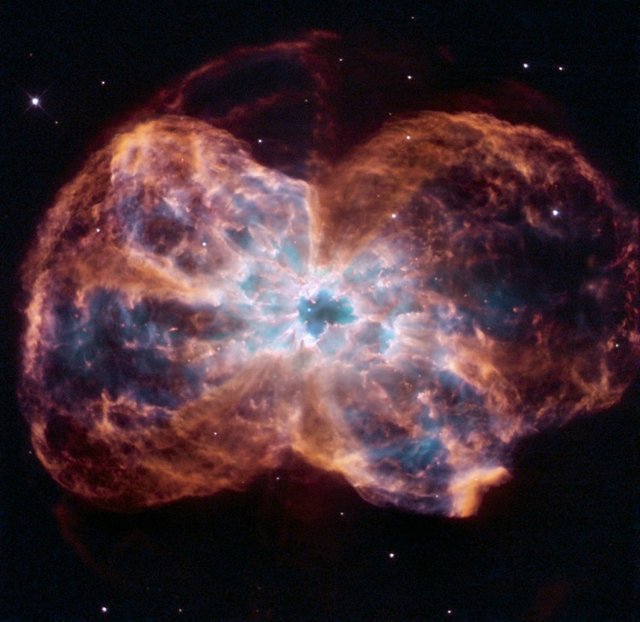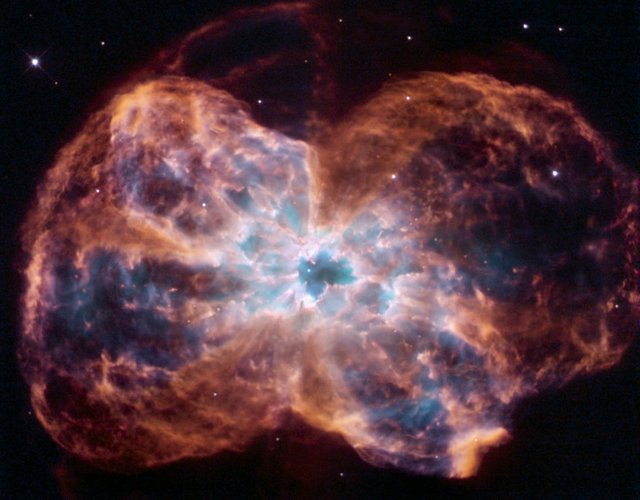Hubble Views a Colorful Demise of a Sun-like Star

This image, taken by the NASA/ESA Hubble Space Telescope, shows the colorful "last hurrah" of a star like our sun. The star is ending its life by casting off its outer layers of gas, which formed a cocoon around the star's remaining core. Ultraviolet light from the dying star makes the material glow. The burned-out star, called a white dwarf, is the white dot in the center. Our sun will eventually burn out and shroud itself with stellar debris, but not for another 5 billion years.
Our Milky Way Galaxy is littered with these stellar relics, called planetary nebulae. The objects have nothing to do with planets. Eighteenth- and nineteenth-century astronomers called them the name because through small telescopes they resembled the disks of the distant planets Uranus and Neptune. The planetary nebula in this image is called NGC 2440. The white dwarf at the center of NGC 2440 is one of the hottest known, with a surface temperature of more than 360,000 degrees Fahrenheit (200,000 degrees Celsius). The nebula's chaotic structure suggests that the star shed its mass episodically. During each outburst, the star expelled material in a different direction. This can be seen in the two bowtie-shaped lobes. The nebula also is rich in clouds of dust, some of which form long, dark streaks pointing away from the star. NGC 2440 lies about 4,000 light-years from Earth in the direction of the constellation Puppis.
The material expelled by the star glows with different colors depending on its composition, its density and how close it is to the hot central star. Blue samples helium; blue-green oxygen, and red nitrogen and hydrogen.

Это изображение, принятое NASA / ESA космического телескопа Хаббла, показывает красочные "последнее" ура звезды, как наше Солнце. Звезда заканчивает свою жизнь, сбрасывая свои внешние слои газа, которые сформировали кокон вокруг оставшегося ядра звезды. Ультрафиолетовый свет от умирающей звезды делает материал свечение. Сгоревший звезда, называется белым карликом, является белая точка в центре. Наше солнце будет в конце концов выгорает и окутать себя со звездным мусором, но не в течение еще 5 миллиардов лет.
Наша Галактика Млечный Путь усеяна этими звездных реликвий, называемых планетарными туманностями. Объекты не имеют ничего общего с планетами. И восемнадцатого девятнадцатого века астрономы назвали их имя, потому что через маленькие телескопы они напоминали диски далеких планет Урана и Нептуна. Планетарная туманность в этом изображении называется NGC 2440. Белый карлик в центре NGC 2440 является одним из самых горячих известно, с температурой поверхности более 360000 градусов по Фаренгейту (200000 градусов по Цельсию). хаотическая структура туманности свидетельствует о том, что звезда пролил свою массу эпизодически. Во время каждой вспышки, звезда изгнали материал в другом направлении. Это можно увидеть в двух Боути-образных лопастей. Туманность также богат облаками пыли, некоторые из которых образуют длинные, темные полосы, указывающие расстояние от звезды. NGC 2440 находится на расстоянии около 4000 световых лет от Земли в направлении созвездия Кормы.
Материал изгнан звезды сверкает разными цветами в зависимости от ее состава, ее плотность и насколько близко она к горячей центральной звезды. Синие образцы гелия; сине-зеленый кислород, и красный азот и водород.
This is a copy-pasted article, then google-translated to Russian.
Source: https://www.sciencedaily.com/releases/2016/09/160923154925.htm
Copying/Pasting full texts is frowned upon by the community. Sharing content by itself adds no original content and no value.
Sharing content and adding value by:
Repeated copy/paste posts are considered spam. Spam is discouraged by the community, and may result in action from the cheetah bot.
Creative Commons: If you are posting content under a Creative Commons license, please attribute and link according to the specific license. If you are posting content under CC0 or Public Domain please consider noting that at the end of your post.
Not indicating that the content you copy/paste is not your original work could be seen as plagiarism.
If you are actually the original author, please do reply to let us know!
Thank You!